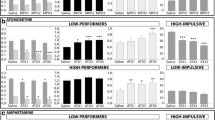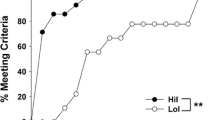Abstract
Rationale
Previous studies of mice (Mus domesticus) selectively bred for high voluntary wheel running have suggested that the hyperactivity is associated with dysfunction in the dopaminergic neuromodulatory system and that high-running mice may represent a useful genetic model for attention deficit hyperactivity disorder (ADHD).
Objectives
We tested the hypothesis that mice from the four replicate hyperactive lines would respond differently to methylphenidate (Ritalin), apomorphine (non-selective dopamine agonist), SCH 23390 (selective D1-like dopamine antagonist), and raclopride (selective D2-like dopamine antagonist) than individuals from the four replicate, randomly bred, control lines.
Methods
After animals were habituated (3 weeks) to their cages with attached wheels, drugs were administered via intraperitoneal injections, at night, during peak wheel-running activity. Revolutions on wheels 10–70 min post-injection were used to quantify drug responses.
Results
Ritalin (15 mg/kg and 30 mg/kg) increased wheel running in control lines but decreased running in selected lines. A low-dose (0.125 mg/kg) of apomorphine reduced wheel running by a similar amount in control and selected lines; however, higher doses of apomorphine (0.25 mg/kg and 0.5 mg/kg) produced greater reductions in wheel running in the control lines. SCH 23390 (0.025, 0.05, and 0.1 mg/kg) caused greater reductions in wheel running in control than in selected lines. Raclopride (0.5, 1, and 2 mg/kg) reduced wheel running by a similar amount in control and selected lines.
Conclusions
These results support the interpretation that genetically determined hyperactive wheel-running behavior is associated with altered dopaminergic function in this mouse model. More specifically, results suggest that D1-like (D1 or D5), but not D2-like (D2, D3, or D4), dopamine receptors have reduced function in the high-running mice. The fact that Ritalin decreased wheel running in selected lines further supports their use as an animal model of ADHD.


Similar content being viewed by others
References
Alleweireldt AT, Weber SM, Kirschner KF, Bullock BL, Neisewander JL (2002) Blockade or stimulation of D1 dopamine receptors attenuates cue reinstatement of extinguished cocaine-seeking behavior in rats. Psychopharmacology 159:284–293
Andersen PH (1988) Comparison of the pharmacological characteristics of [3H]raclopride and [3H]SCH 23390 binding to dopamine receptors in vivo in mouse brain. Eur J Pharmacol 146:113–120
Arnsten AFT (2001) Dopaminergic and noradrenergic influences on cognitive function mediated by prefrontal cortex. In: Solanto MV, Arnsten AFT, Castellanos FX (eds) Stimulant drugs and ADHD. Oxford University Press, Oxford, pp 185–208
Baik JH, Picetti R, Saiardi A, Thiriet G, Dierich A, Depaulis A, Le Meur M, Borrelli E (1995) Parkinsonian-like locomotor impairment in mice lacking dopamine D2 receptors. Nature 377:424–428
Berridge KC, Robinson TE (1998) What is the role of dopamine in reward: hedonic impact, reward learning, or incentive salience? Brain Res Brain Res Rev 28:309–369
Beurrier C, Malenka R (2002) Enhanced inhibition of synaptic transmission by dopamine in the nucleus accumbens during behavioral sensitization to cocaine. J Neurosci 22:5817–5822
Britton SL, Koch LG (2001) Animal genetic models for complex traits of physical capacity. Exerc Sport Sci Rev 29:7–14
Cabib S, Puglisi-Allegra S (1985) Different effects of apomorphine on climbing behavior and locomotor activity in three strains of mice. Pharmacol Biochem Behav 23:555–557
Capper-Loup C, Canales JJ, Kadaba N, Graybiel AM (2002) Concurrent activation of dopamine D1 and D2 receptors is required to evoke neural and behavioral phenotypes of cocaine sensitization. J Neurosci 22:6218–6227
Castellanos FX (2001) Neuroimaging studies of ADHD. In: Solanto MV, Arnsten AFT, Castellanos FX (eds) Stimulant drugs and ADHD. Oxford University Press, Oxford, pp 243–258
Cook EH Jr, Stein MA, Krasowski MD, Cox NJ, Olkon DM, Kieffer JE, Leventhal BL (1995) Association of attention-deficit disorder and the dopamine transporter gene. Am J Hum Genet 56:993–998
Falconer D, Mackay T (1996) Introduction to quantitative genetics, 4th edn. Longman, Essex
Ferguson S (2001) A review of rodent models of ADHD. In: Solanto MV, Arnsten AFT, Castellanos FX (eds) Stimulant drugs and ADHD. Oxford University Press, Oxford, pp 209–220
Gainetdinov RR, Wetsel WC, Jones SR, Levin ED, Jaber M, Caron MG (1999) Role of serotonin in the paradoxical calming effect of psychostimulants on hyperactivity. Science 283:397–401
Garland T (2003) Selection experiments: an underutilized tool in biomechanics and organismal biology. In: Gasc JP, Casinos A, Bels VL (eds) Vertebrate biomechanics and evolution, vol I. Bios Scientific Publishers, Oxford, pp 23–56
Garland T Jr, Morgan M, Swallow J, Rhodes J, Girard I, Belter J, Carter P (2002) Evolution of a small-muscle polymorphism in lines of house mice selected for high activity levels. Evolution 56:1267–1275
Girard I, McAleer MW, Rhodes JS, Garland T Jr (2001) Selection for high voluntary wheel-running increases speed and intermittency in house mice (Mus domesticus). J Exp Biol 204:4311–4320
Greenwald MK, Schuster CR, Johanson CE, Jewell J (1998) Automated measurement of motor activity in human subjects: effects of repeated testing and d-amphetamine. Pharmacol Biochem Behav 59:59–65
Henderson N (1989) Interpreting studies that compare high- and low-selected lines on new characters. Behav Genet 19:473–502
Henderson N (1997) Spurious association in unreplicated selected lines. Behav Genet 27:145–154
Ichihara K, Nabeshima T, Kameyama T (1993) Mediation of dopamine D1 and D2 receptors in the effects of GBR 12909 on latent learning and locomotor activity in mice. Eur J Pharmacol 234:155–163
Jarvie KR, Caron MG (1993) Heterogeneity of dopamine receptors. Adv Neurol 60:325–333
Kelley AE, Cador M (1988) Behavioral evidence for differential neuropeptide modulation of the mesolimbic dopamine system. Ann NY Acad Sci 537:415–434
Koob GF (1996) Hedonic valence, dopamine and motivation. Mol Psychiatry 1:186–189
Koteja P, Garland T Jr (2001) Forum. Response to R. Eikelboom. Anim Behav 61:F25–F26
Levy F, Swanson JM (2001) Timing, space and ADHD: the dopamine theory revisited. Aust N Z J Psychiatry 35:504–511
Marley RJ, Arros DM, Henricks KK, Marley ME, Miner LL (1998) Sensitivity to cocaine and amphetamine among mice selectively bred for differential cocaine sensitivity. Psychopharmacology 140:42–51
Messier C, Mrabet O, Destrade C (1992) Locomotor bias produced by intra-accumbens injection of dopamine agonists and antagonists. Pharmacol Biochem Behav 41:177–182
Milliken GA, Johnson DE (1992) Analysis of messy data. Chapman and Hall, New York
Morris TH (1999) Dose estimation among species. In: Hawk CT, Leary SL (eds) Formulary for laboratory animals. Iowa State University Press, Iowa
Nestler EJ, Barrot M, Self DW (2001) Delta fosB: a sustained molecular switch for addiction. Proc Natl Acad Sci USA 98:11042–11046
Papa M, Sellitti S, Sadile AG (2000) Remodeling of neural networks in the anterior forebrain of an animal model of hyperactivity and attention deficits as monitored by molecular imaging probes. Neurosci Biobehav Rev 24:149–156
Pennartz CM, Dolleman-Van der Weel MJ, Kitai ST, Lopes da Silva FH (1992) Presynaptic dopamine D1 receptors attenuate excitatory and inhibitory limbic inputs to the shell region of the rat nucleus accumbens studied in vitro. J Neurophysiol 67:1325–1334
Porrino LJ, Rapoport JL, Behar D, Sceery W, Ismond DR, Bunney WE Jr (1983) A naturalistic assessment of the motor activity of hyperactive boys. I. Comparison with normal controls. Arch Gen Psychiatry 40:681–687
Rapoport JL, Buchsbaum MS, Zahn TP, Weingartner H, Ludlow C, Mikkelsen EJ (1978) Dextroamphetamine: cognitive and behavioral effects in normal prepubertal boys. Science 199:560–563
Rhodes JS, Hosack GR, Girard I, Kelley AE, Mitchell GS, Garland T Jr (2001) Differential sensitivity to acute administration of cocaine, GBR 12909, and fluoxetine in mice selectively bred for hyperactive wheel-running behavior. Psychopharmacology 158:120–131
Robbins TW, Sahakian BJ (1979) "Paradoxical" effects of psychomotor stimulant drugs in hyperactive children from the standpoint of behavioural pharmacology. Neuropharmacology 18:931–950
Robinson TE, Berridge KC (1993) The neural basis of drug craving: an incentive-sensitization theory of addiction. Brain Res Brain Res Rev 18:247–291
Russell V, de Villiers A, Sagvolden T, Lamm M, Taljaard J (1995) Altered dopaminergic function in the prefrontal cortex, nucleus accumbens and caudate-putamen of an animal model of attention-deficit hyperactivity disorder—the spontaneously hypertensive rat. Brain Res 676:343–351
Russell V, de Villiers A, Sagvolden T, Lamm M, Taljaard J (1998) Differences between electrically-, ritalin- and d-amphetamine-stimulated release of [3H]dopamine from brain slices suggest impaired vesicular storage of dopamine in an animal model of attention-deficit hyperactivity disorder. Behav Brain Res 94:163–171
Sagvolden T (2000) Behavioral validation of the spontaneously hypertensive rat (SHR) as an animal model of attention-deficit/hyperactivity disorder (AD/HD). Neurosci Biobehav Rev 24:31–39
Sagvolden T, Sergeant JA (1998) Attention deficit/hyperactivity disorder—from brain dysfunctions to behaviour. Behav Brain Res 94:1–10
Sagvolden T, Metzger MA, Schiorbeck HK, Rugland AL, Spinnangr I, Sagvolden G (1992) The spontaneously hypertensive rat (SHR) as an animal model of childhood hyperactivity (ADHD): changed reactivity to reinforcers and to psychomotor stimulants. Behav Neural Biol 58:103–112
Salamone JD (1996) The behavioral neurochemistry of motivation: methodological and conceptual issues in studies of the dynamic activity of nucleus accumbens dopamine. J Neurosci Methods 64:137–149
Sanger DJ, Blackman DE (1976) Rate-dependent effects of drugs: a review of the literature. Pharmacol Biochem Behav 4:73–83
Shaywitz BA, Klopper JH, Gordon JW (1978) Methylphenidate in 6-hydroxydopamine-treated developing rat pups. Effects on activity and maze performance. Arch Neurol 35:463–469
Sherwin CM (1998) Voluntary wheel running: a review and novel interpretation. Anim Behav 56:11–27
Simon VM, Parra A, Minarro J, Arenas MC, Vinader-Caerols C, Aguilar MA (2000) Predicting how equipotent doses of chlorpromazine, haloperidol, sulpiride, raclopride and clozapine reduce locomotor activity in mice. Eur Neuropsychopharmacol 10:159–164
Smialowski A, Bijak M (1987) Excitatory and inhibitory action of dopamine on hippocampal neurons in vitro. Involvement of D2 and D1 receptors. Neuroscience 23:95–101
Smith-Roe SL, Kelley AE (2000) Coincident activation of NMDA and dopamine D1 receptors within the nucleus accumbens core is required for appetitive instrumental learning. J Neurosci 20:7737–7742
Solanto MV (1998) Neuropsychopharmacological mechanisms of stimulant drug action in attention-deficit hyperactivity disorder: a review and integration. Behav Brain Res 94:127–152
Solanto MV (2000) Clinical psychopharmacology of AD/HD: implications for animal models. Neurosci Biobehav Rev 24:27–30
Solanto MV, Arnsten AFT, Castellanos FX (2001) Stimulant drugs and ADHD. Oxford University Press, Oxford
Swallow JG, Carter PA, Garland T Jr (1998) Artificial selection for increased wheel-running behavior in house mice. Behav Genet 28:227–237
Swanson JM, Flodman P, Kennedy J, Spence MA, Moyzis R, Schuck S, Murias M, Moriarity J, Barr C, Smith M, Posner M (2000) Dopamine genes and ADHD. Neurosci Biobehav Rev 24:21–25
Thal L, Creese I, Snyder SH (1978) 3H-Apomorphine interactions with dopamine receptors in calf brain. Eur J Pharmacol 49:295–299
Todd RD (2000) Genetics of attention deficit/hyperactivity disorder: are we ready for molecular genetic studies? Am J Med Genet 96:241–243
Vallone D, Picetti R, Borrelli E (2000) Structure and function of dopamine receptors. Neurosci Biobehav Rev 24:125–132
Weissenborn R, Deroche V, Koob GF, Weiss F (1996) Effects of dopamine agonists and antagonists on cocaine-induced operant responding for a cocaine-associated stimulus. Psychopharmacology 126:311–322
Werme M, Messer C, Olson L, Gilden L, Thoren P, Nestler EJ, Brene S (2002) Delta fosB regulates wheel running. J Neurosci 22:8133–8138
Womer DE, Jones BC, Erwin VG (1994) Characterization of dopamine transporter and locomotor effects of cocaine, GBR 12909, epidepride, and SCH 23390 in C57BL and DBA mice. Pharmacol Biochem Behav 48:327–335
Acknowledgements
Supported by NSF grants IBN-9728434 and IBN-0212567 to T.G., and NIH grant P30 HD03352 (P.I.: Terrence R. Dolan). J.S.R. was supported by NINDS fellowship NS42872–02.
Author information
Authors and Affiliations
Corresponding author
Rights and permissions
About this article
Cite this article
Rhodes, J.S., Garland, T. Differential sensitivity to acute administration of Ritalin, apormorphine, SCH 23390, but not raclopride in mice selectively bred for hyperactive wheel-running behavior. Psychopharmacology 167, 242–250 (2003). https://doi.org/10.1007/s00213-003-1399-9
Received:
Accepted:
Published:
Issue Date:
DOI: https://doi.org/10.1007/s00213-003-1399-9




